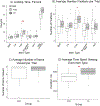Attention Allocation During Exploration of Visual Arrays in ASD: Results from the ABC-CT Feasibility Study
- PMID: 35657448
- PMCID: PMC10980886
- DOI: 10.1007/s10803-022-05569-0
Attention Allocation During Exploration of Visual Arrays in ASD: Results from the ABC-CT Feasibility Study
Abstract
Visual exploration paradigms involving object arrays have been used to examine salience of social stimuli such as faces in ASD. Recent work suggests performance on these paradigms may associate with clinical features of ASD. We evaluate metrics from a visual exploration paradigm in 4-to-11-year-old children with ASD (n = 23; 18 males) and typical development (TD; n = 23; 13 males). Presented with arrays containing faces and nonsocial stimuli, children with ASD looked less at (p = 0.002) and showed fewer fixations to (p = 0.022) faces than TD children, and spent less time looking at each object on average (p = 0.004). Attention to the screen and faces correlated positively with social and cognitive skills in the ASD group (ps < .05). This work furthers our understanding of objective measures of visual exploration in ASD and its potential for quantifying features of ASD.
Keywords: Autism spectrum disorder; Eye-tracking; Visual exploration; Visual processing; Visual search.
© 2022. The Author(s), under exclusive licence to Springer Science+Business Media, LLC, part of Springer Nature.
Figures


Similar articles
-
The salience of competing nonsocial objects reduces gaze toward social stimuli, but not the eyes, more in typically developing than autistic boys.Autism Res. 2022 Jun;15(6):1043-1055. doi: 10.1002/aur.2714. Epub 2022 Mar 31. Autism Res. 2022. PMID: 35357777
-
Atypical Value-Driven Selective Attention in Young Children With Autism Spectrum Disorder.JAMA Netw Open. 2020 May 1;3(5):e204928. doi: 10.1001/jamanetworkopen.2020.4928. JAMA Netw Open. 2020. PMID: 32374399 Free PMC article.
-
Visual attention to faces in children with autism spectrum disorder: are there sex differences?Mol Autism. 2019 Jun 28;10:28. doi: 10.1186/s13229-019-0276-2. eCollection 2019. Mol Autism. 2019. PMID: 31297179 Free PMC article.
-
Social attention in ASD: A review and meta-analysis of eye-tracking studies.Res Dev Disabil. 2016 Jan;48:79-93. doi: 10.1016/j.ridd.2015.10.011. Epub 2015 Nov 6. Res Dev Disabil. 2016. PMID: 26547134 Review.
-
Eye-Tracking in Infants and Young Children at Risk for Autism Spectrum Disorder: A Systematic Review of Visual Stimuli in Experimental Paradigms.J Autism Dev Disord. 2021 Aug;51(8):2578-2599. doi: 10.1007/s10803-020-04731-w. J Autism Dev Disord. 2021. PMID: 33011860
Cited by
-
Editorial: Precision medicine approaches for heterogeneous conditions such as autism spectrum disorders (The need for a biomarker exploration phase in clinical trials - Phase 2m).Front Psychiatry. 2023 Jan 19;13:1079006. doi: 10.3389/fpsyt.2022.1079006. eCollection 2022. Front Psychiatry. 2023. PMID: 36741580 Free PMC article. No abstract available.
-
A functional model for studying common trends across trial time in eye tracking experiments.Stat Biosci. 2023 Apr;15(1):261-287. doi: 10.1007/s12561-022-09354-6. Epub 2022 Sep 5. Stat Biosci. 2023. PMID: 37077750 Free PMC article.
References
-
- American Psychiatric Association. 2013. Diagnostic and Statistical Manual of Mental Disorders: DSM-5. Arlington, Va.: American Psychiatric Association.
-
- Brenner Laurie a, Turner Katherine C., and Müller Ralph-Axel. 2007. “Eye Movement and Visual Search: Are There Elementary Abnormalities in Autism?” Journal of Autism and Developmental Disorders 37(7):1289–1309. - PubMed
MeSH terms
Grants and funding
LinkOut - more resources
Full Text Sources
Medical

